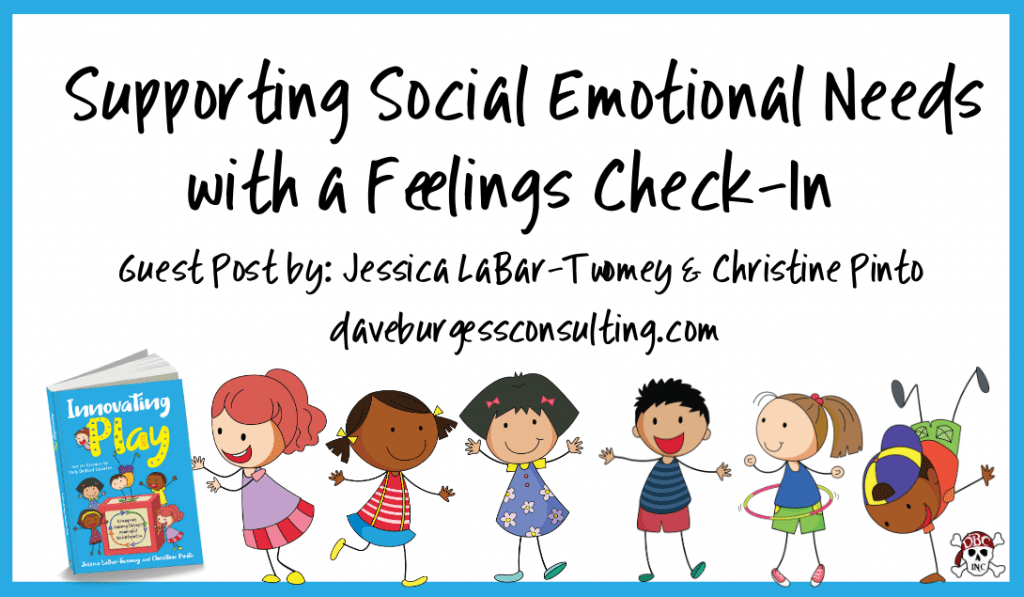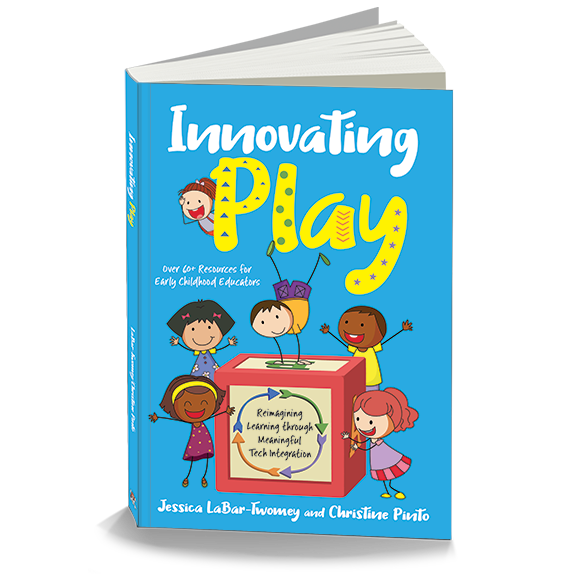Have you read Innovating Play by Christine Pinto & Jessica LaBar-Twomey?
It's SO good!
Technology isn’t just a way to innovate instruction; it’s also the key to building classrooms that are dynamic, playful, and truly connected. In Innovating Play, early childhood educators Jessica LaBar-Twomey and Christine Pinto share the insights that led their kindergarten classes to generative, daily collaborations from opposite ends of the United States. In the process, they offer elementary educators a powerful set of digital tools that transform social-emotional learning.
Learn more about Innovating Play by clicking the book link below this incredible post.
But, for now...let's learn from the authors!
Take it away, Christine & Jessica!
Guest Post by: Christine Pinto & Jessica LaBar-Twomey
There are a variety of ways that educators take care of their students and their needs in the classroom, but what does this look like during distance learning? In this post, we share about our Feelings Check-In ritual that originally started in the classroom, and how that has transferred into distance learning environments.
Feelings Check-In at School
In the classroom, one of our components during our Community Gathering time is our Feelings Check-In. During this ritual children share their expressions with the teacher and their peers. This involves everyone quietly noticing the facial and body clues of those around them. The teacher continues to facilitate this ritual by calling on a child to verbally check in with another peer to share what s/he notices about that child to try to identify their feeling. The child may say something like, “Her mouth is frowning, her eyes are not looking at me, her body is still...I think she is feeling sad." The class continues to check in with that child to find out more about his/her feeling, and as necessary offer connections, love, and solutions. The feeling is then explored via our Feelings Heart in Google Slides. Each feeling piece in the heart is linked to a selection of videos from GoNoodle meant to address that feeling. After selecting a GoNoodle experience, children participate together, then come together to bring closure by heading to our gratitude slide and share what they are grateful for. You can find more information about utilizing the Feelings Heart resource and facilitating the Feelings Check-In ritual in Chapter 2 of our Innovating Play book.
Feelings Check-In During Distance Learning
Hybrid Setting
Many teachers are navigating the unique dynamics of the hybrid learning model. We are simultaneously looking for solutions for the challenges that come with not being able to see each other while masked in the classroom, and including children at home so that they feel validated and cared for on the screen. The Feelings Check-In remains a vital piece of our connection as we start each day together. We begin by having the remote learners projected so that the students in the classroom can see them. In this version of the Feelings Check-In, the children in the classroom carefully study the expressions of the children on the screen. Classroom learners are empowered to share their thoughts as they ask questions to specific friends, while children at home are celebrated by utilizing the pin/spotlight feature to share their feelings one at a time. Children practice having appropriate conversation back and forth as they develop understanding of the importance of words, facial cues, and body language in communicating. This interaction may then be followed with the Feelings Heart so that all children engage in movement and connection through a shared GoNoodle strategy. The Feelings Check-In provides common ground for a shared emotional experience that sets the tone for learning each day in our hybrid model.
All Remote Setting
Onscreen class meetings in the remote learning model provide a wonderful space for a Feelings Check-In to start the day. The children begin by making sure that everyone on their screen is visible as we take a moment to quietly look at the expressions of all of our classmates. Students are then randomly selected to check in with a friend by sharing their ideas about what they noticed through the expression and body language of that peer. Pairs of children participate in a back and forth exchange to ask and answer questions using specific feeling words, evidence of body language and expression, as well as reasons for experiencing each feeling. Children then have the opportunity to get up and move as a whole class while the Feelings Heart is used to explore one of the identified feelings that day. This class ritual helps to develop and nurture the class community as children feel safe, heard, and included through the experience.
Transfer Back to the Classroom
In and out of the classroom, shared digital spaces that value emotional connections create opportunities for children to understand that beyond the screen, there are other human beings. The Feelings Check-In addresses self-reflection, empathy between people in a shared physical space, and empathy for others beyond the classroom. It is this deep understanding that can potentially transfer to every other digital interaction that children have for the rest of their lives. If IN the foundation of utilizing technology we include a shared human experience, then we can break down barriers, build solutions, lift each other up, create possibilities for living, and elevating humanity.
-Christine & Jessica
Thank you, Christine & Jessica!
Be sure to follow Christine Pinto & Jessica LaBar-Twomey on Twitter by clicking their names. Also, check out their website right HERE.
And don't forget to preview Innovating Play for FREE by clicking the link below! It's AMAZING!!
Innovating Play
Tech integration for early childhood education as thoughtful as it is wholehearted
More info →





